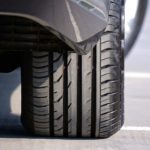 While there is no hard and fast stopping distance to maintain between vehicles, Virginia law does include a section defining a fine you may encounter on the roadways called ‘following too closely’ the details are listed as “The driver of a motor vehicle shall not follow another vehicle, trailer, or semitrailer more closely than is reasonable and prudent, having due regard to the speed of both vehicles and the traffic on, and conditions of, the highway at the time.”
While there is no hard and fast stopping distance to maintain between vehicles, Virginia law does include a section defining a fine you may encounter on the roadways called ‘following too closely’ the details are listed as “The driver of a motor vehicle shall not follow another vehicle, trailer, or semitrailer more closely than is reasonable and prudent, having due regard to the speed of both vehicles and the traffic on, and conditions of, the highway at the time.”
So what is an adequate stopping distance? Unfortunately, this depends on your unique situation at the time of collision as in the case of the above fine. However, we can recommend maintaining at least 40 feet between your car and the car ahead of you at most times. But there are many things that can factor into your stopping distance.
Five things that can factor into the stopping distance you have available on the road:
- Road Condition – This is highly dependant on the weather and can include the amount condensation or standing water left by rain or fog, debris from fallen leaves, the temperature of the road, and even the state of repair the road is in. Adding any slippery surface that reduces the friction between your tires and the road is inevitably going to have an effect on your braking. In rain and snow, the braking distance used at different speeds may sometimes double in order to compensate for less traction with the roadway.
- Tire Condition – Traction with the road, of course, starts with your tire quality! When was the last time you had your tires replaced? Virginia vehicle inspection law states: “If the tread depth is less than 2/32 of an inch in two adjacent tread grooves at each of the equally spaced intervals, the tire must be rejected.” You can have your vehicles inspected regularly to ensure safe travel.
- Speed of Travel – Above all other things, speed will control your stopping distance like no other factor. at 20 MPH you can expect to maintain a 40-foot following distance for safe travel. As speeds increase, your following distance will increase as well, all the way up to roughly 140 feet for 60 MPH travel.
- Field of View – Visibility is one of a number of factors that do not affect your braking distance per se but can inhibit your thinking distance. The longer it takes for you to spot hazards in the road, the more time will have passed before you hit the brake pedal.
- Driver State of Mind – As many as one-fifth of accidents on highways may be caused by drivers falling asleep at the wheel. Tired driving can impact your reaction time and impair your decision-making ability. It is imperative that if you are driving long distances, or feel yourself becoming drowsy, that you take breaks often.
You can’t control other drivers on the road, and sometimes collisions will happen. When they do and you find yourself injured or seeking legal advice, contact us at 1-804-368-6368 or toll-free at 1-877-825-0543 for a free consultation to discuss your case. Let us put our resources to work for you.

